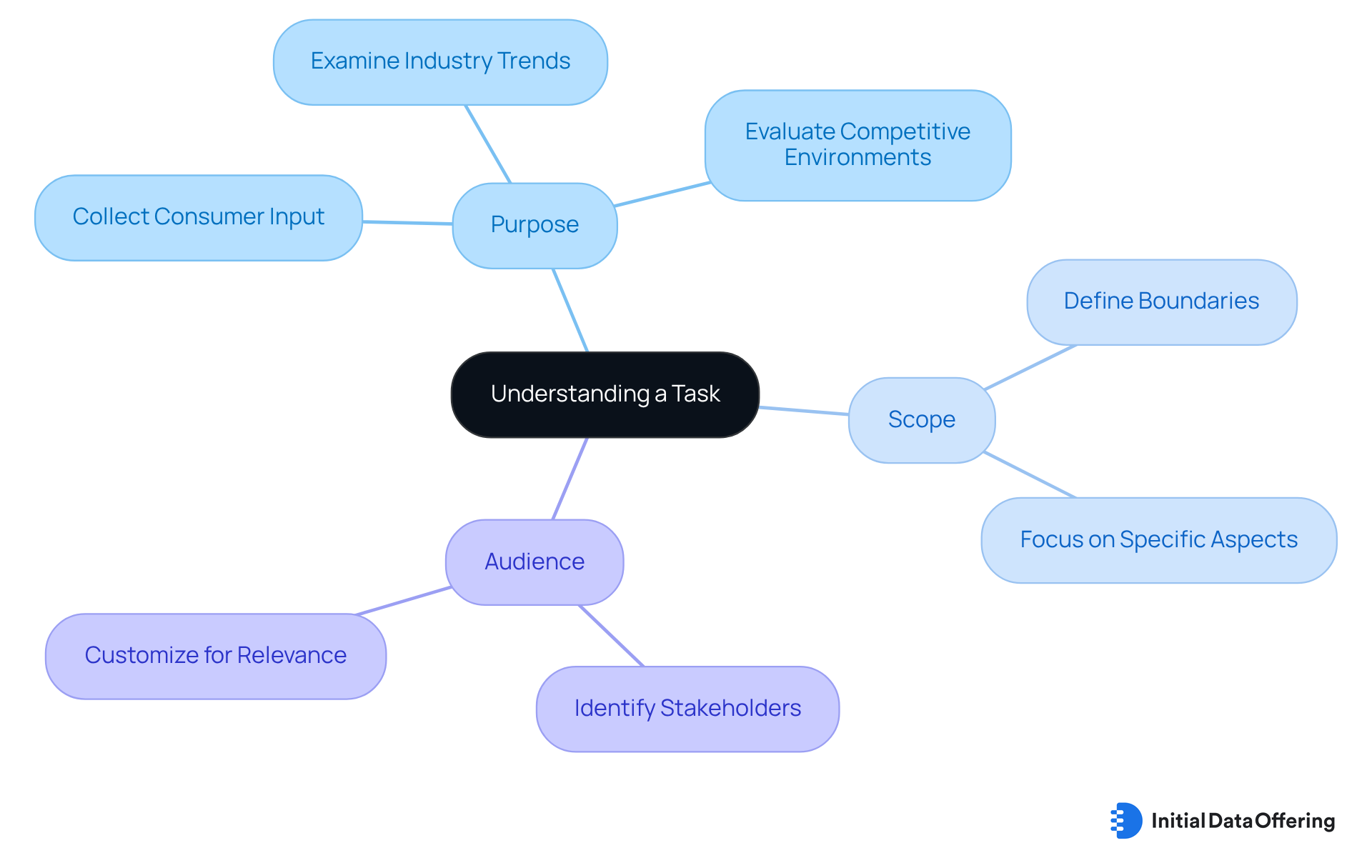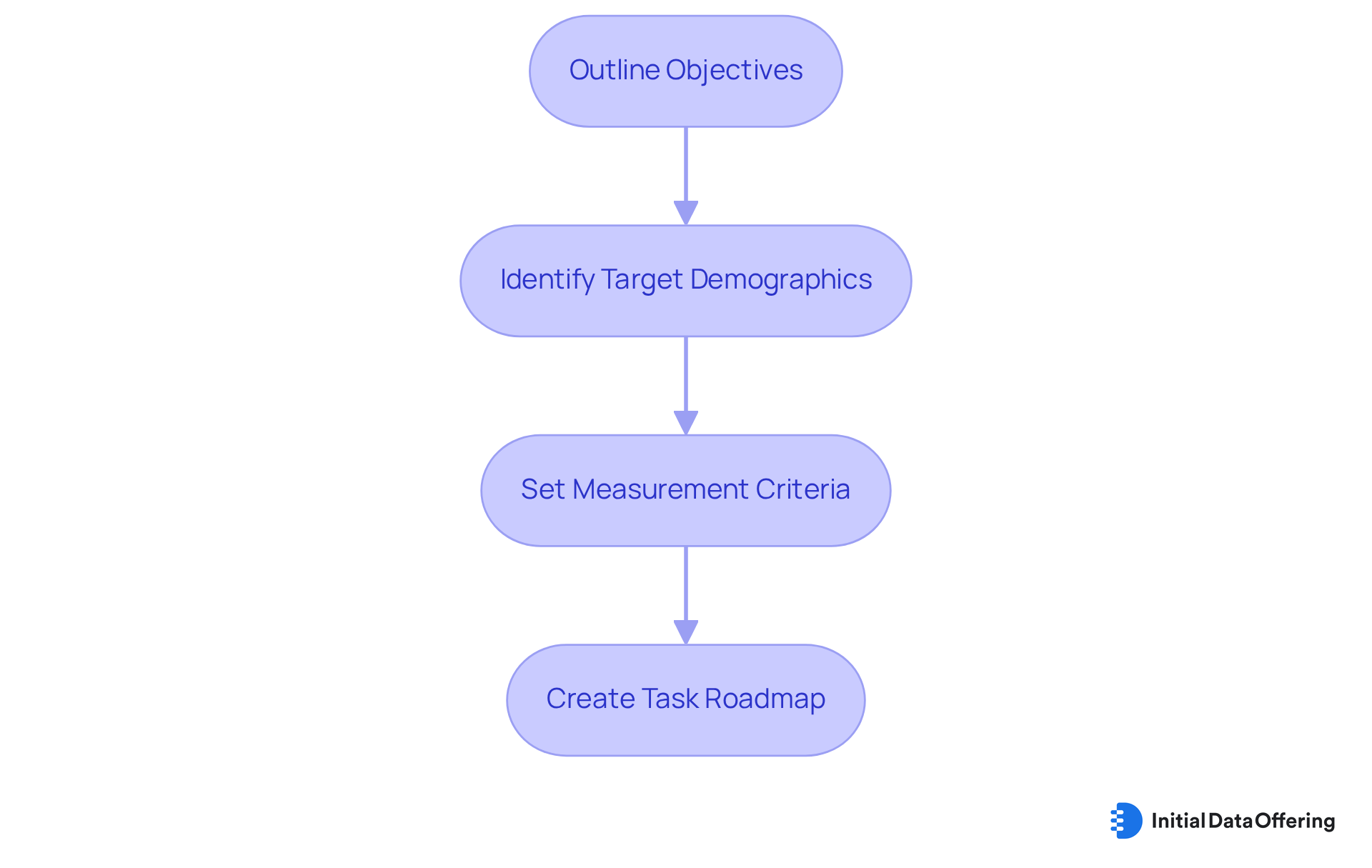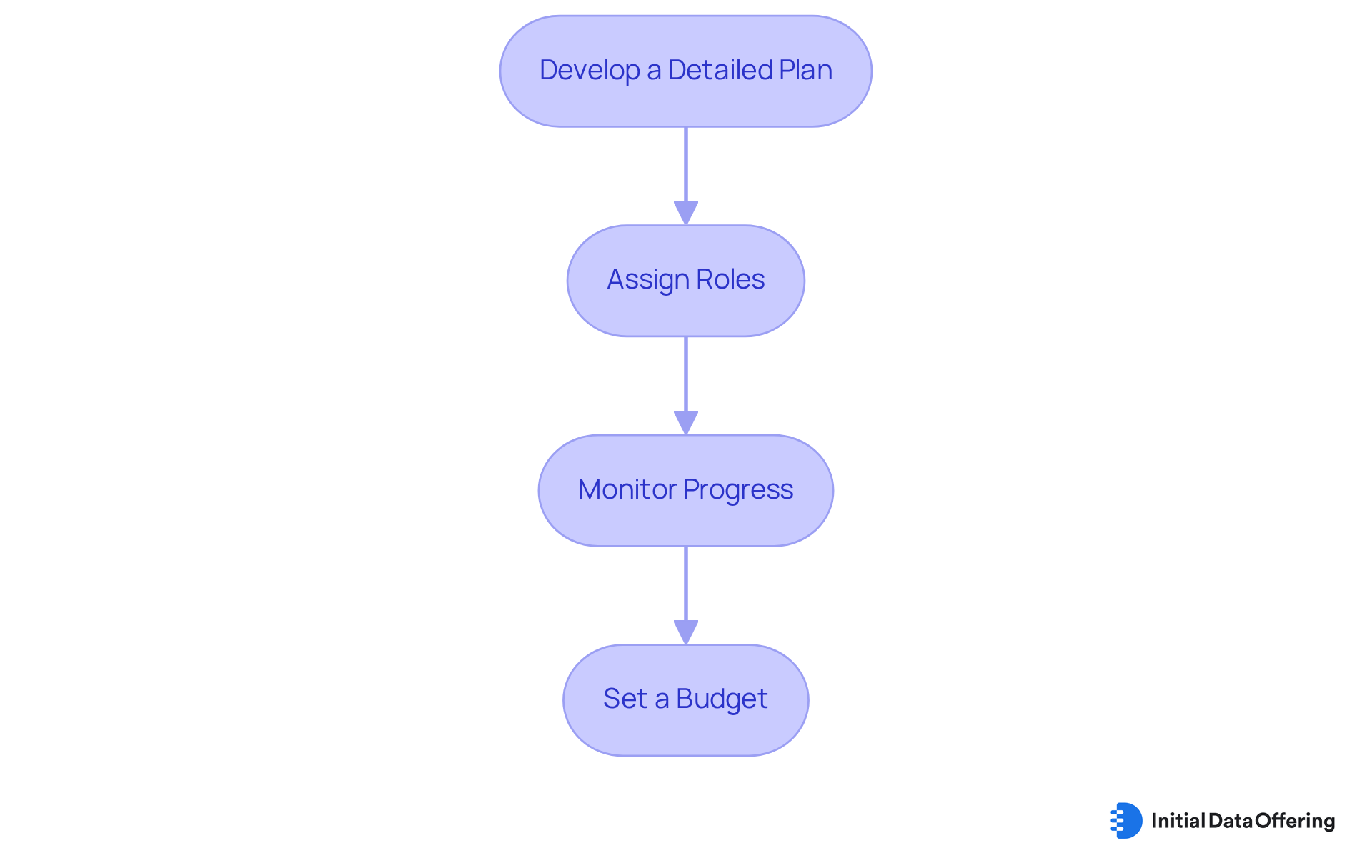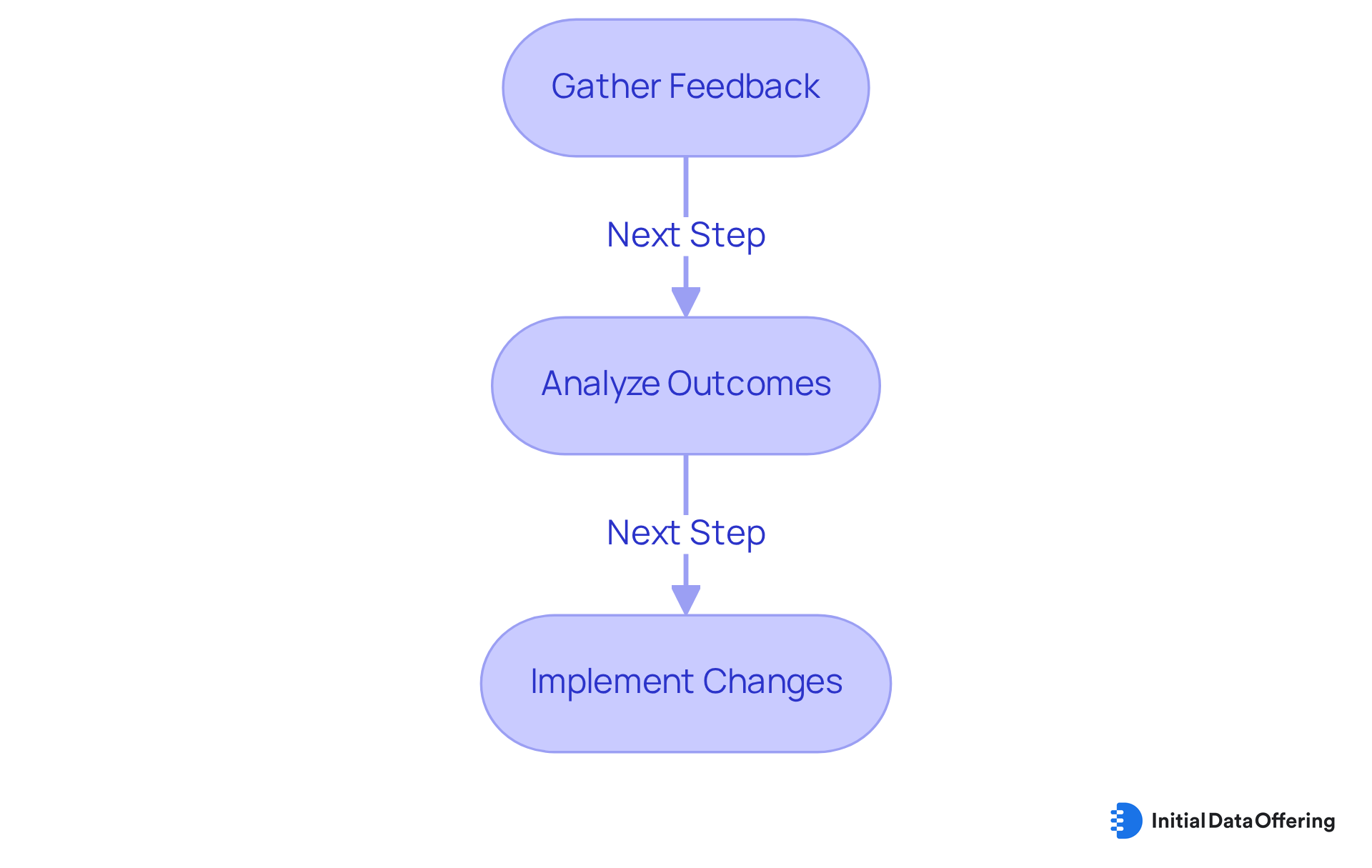5 Steps to Create Task Effectively for Market Research

5 Steps to Create Task Effectively for Market Research
Overview
The article outlines five essential steps for creating effective tasks in market research. These steps include:
- Understanding the task's purpose
- Setting up the environment
- Defining parameters
- Executing the creation process
- Reviewing outcomes
Each step is supported by practical advice and examples. This approach emphasizes the importance of clear objectives, collaboration, and continuous improvement. By focusing on these elements, market research initiatives can significantly enhance their quality and effectiveness.
How can these steps be integrated into your current practices to yield better results?
Introduction
Creating effective tasks in market research is not merely a procedural necessity; it stands as a strategic imperative that can significantly influence the quality of insights gathered. By understanding the nuances of task creation, organizations can unlock a wealth of information that drives decision-making and fosters innovation.
However, many organizations encounter challenges when navigating the complexities of task definition, execution, and optimization. How can businesses ensure that their approach to task management not only meets their objectives but also adapts to the ever-evolving market landscape?
This question is crucial as it leads to a deeper exploration of effective task management strategies.
Understand the Concept of a Task
An assignment in consumer research represents a or goal aimed at or . This can encompass a range of activities, from conducting surveys to . To effectively create a task, consider the following aspects:
- Identify the Purpose: Why is this task necessary? Is it intended to collect consumer input, examine , or ?
- Determine the Scope: What are the boundaries of the assignment? Focus on specific aspects of the market or consumer behavior that are pertinent to your objectives.
- Consider the Audience: Who will be impacted by the outcomes of this endeavor? to meet the needs of stakeholders is crucial for ensuring relevance and effectiveness.
By establishing a clear understanding of what an assignment entails, you lay a solid foundation for a .

Set Up Your Task Environment
Establishing your task environment involves arranging the necessary resources and tools for efficient . This process can significantly . Here are the steps to follow:
- : Identify and collect tools that will aid in your research. For , consider using survey software like Typeform or Google Forms. such as Tableau or Google Analytics provide valuable insights, while project management tools like Asana or Trello help keep your team organized. As Gordana Laskovic highlights, "Structuring your knowledge base is vital for efficient management of inquiries." By utilizing these tools, you can streamline your research process and ensure comprehensive data handling.
- Create a : If working with a team, establish a shared platform, such as Google Drive or Microsoft Teams, where all members can access documents, share insights, and track progress. This collaborative atmosphere fosters seamless communication and idea exchange. Current trends emphasize the significance of in improving efficiency in investigations, making it essential to integrate these technologies into your workflow.
- Establish a Timeline: Set deadlines for each phase of the project to ensure timely completion. A clear timeline helps maintain focus and accountability among team members. Furthermore, establishing , including secure VPNs and encrypted communications, is essential for safeguarding data during remote analysis.
By arranging your surroundings with the appropriate tools and collaborative areas, you enhance your capacity to create tasks efficiently and effectively. Notably, the is projected to reach USD 62.4 billion by 2032, underscoring the increasing importance of these tools in market analysis.

Define Task Parameters Clearly
Establishing is essential for directing your investigative efforts effectively. Here are key steps to consider:
- Outline Objectives: Clearly articulate your goals for the task. For instance, if you're conducting a survey, specify the key questions you want answered. Studies indicate that 62% of professionals in different sectors concur that their organizations heavily rely on to adapt to market changes. This statistic highlights the significance of having to ensure that your study aligns with organizational requirements.
- : Determine the specific groups your study will focus on, such as age ranges, geographic locations, or particular consumer segments. Grasping your target audience is crucial, as it enables that align with various consumer requirements and preferences. As Sunil Gupta observes, "Although you can attempt to promote a product to all, customers have various requirements and preferences," emphasizing the importance of focused analysis.
- : Define how you will measure success. This could involve establishing benchmarks for response rates or data accuracy. In 2023, 42% of companies started integrating , indicating a rising trend towards quantifiable results in project tasks. This trend highlights the necessity for clear assessment standards that correspond with current industry expectations.
By setting clear parameters, you create a that guides your efforts and increases the chances of attaining your objectives. This structured approach not only improves the quality of insights gathered but also aligns with the increasing demand for in market research.

Execute the Task Creation Process
Executing the process to create tasks is crucial for translating plans into actionable steps. How can this process be effectively implemented?
- Develop a Detailed Plan:
Outline a that specifies how each task will be executed. This should include timelines, assigned responsibilities, and the necessary resources to ensure smooth execution. For instance, a well-organized strategy can boost leads by 25%, showcasing the significance of . By establishing a clear plan, you set the foundation for successful . - Assign Roles:
In a team setting, it is essential to to team members based on their strengths and areas of expertise. This not only enhances efficiency but also fosters accountability within the team. As Adam Basheer emphasizes, having is a key aspect of a successful , which can be achieved through clear role assignments. How can you leverage your team’s strengths to maximize productivity? - Monitor Progress:
Regularly evaluate the advancement of each assignment to ensure compliance with the timeline and objectives. Utilize project management tools, such as Trello or Asana, to streamline communication and provide updates, allowing for timely adjustments if necessary. is vital for adjusting the marketing plan as needed, ensuring that your efforts remain aligned with your goals. Are you tracking your progress effectively to stay on course?
By carefully creating tasks during the process of , you can improve the organization and efficiency of your analysis efforts, ultimately resulting in more effective outcomes. Additionally, setting a budget is essential to cover all aspects of the marketing plan, ensuring that resources are allocated efficiently. How can you ensure that your with your project goals?

Review and Optimize Your Tasks
Consistently assessing and is vital for maximizing the effectiveness of your . To enhance your process, consider the following key steps:
- Gather Feedback: After completing a task, actively seek and stakeholders. This input is invaluable for pinpointing areas that require improvement and on the research outcomes. As Bill Gates stated, 'Your most unhappy customers are your greatest source of learning,' emphasizing the in refining your processes.
- Analyze Outcomes: Evaluate the results of your assignment against the initial objectives. Did you achieve your goals? Reflect on what worked well and what could have been approached differently to enhance future performance. For instance, Dorel's centralized their approach to consumer feedback, enabling them to respond more effectively to customer needs.
- Implement Changes: Utilize the insights gained from feedback and analysis to to create tasks. Making necessary adjustments ensures that each subsequent initiative is more aligned with your study objectives and stakeholder expectations. Adopting flexible methodologies can further improve your adaptability in a rapidly changing environment.
By consistently reviewing and enhancing your tasks, you not only improve your research capabilities but also ensure that your efforts lead to actionable insights that drive . Embracing a culture of feedback and continuous improvement is vital in today's fast-paced market landscape, where is paramount for success.

Conclusion
Creating effective tasks for market research involves more than merely assigning duties; it requires establishing a strategic framework that drives insightful outcomes. Understanding the concept of a task, setting up an appropriate environment, defining parameters, executing the creation process, and reviewing outcomes significantly enhance researchers' ability to gather actionable insights. This structured approach ensures that every task aligns with overarching goals and stakeholder expectations, ultimately leading to more informed decision-making.
The article outlines essential steps, including:
- Identifying the purpose of tasks
- Gathering necessary tools
- Monitoring progress
These steps are vital for successful market analysis. It emphasizes the importance of defining clear objectives and parameters, as well as the need for continuous optimization through feedback and analysis. By integrating these practices, market researchers can foster a culture of improvement that is responsive to the dynamic nature of consumer behavior and market trends.
In a landscape where understanding consumer needs is paramount, the ability to create and manage tasks effectively can set organizations apart. How can embracing these methodologies enhance research capabilities? By empowering teams to adapt and thrive amidst change, implementing these strategies will lead to more effective market research, ultimately driving better business outcomes and fostering deeper connections with consumers.
Frequently Asked Questions
What is a task in consumer research?
A task in consumer research is a specific objective or goal aimed at gathering insights about a sector or consumer behavior, which can include activities such as conducting surveys or analyzing data trends.
What should be considered when creating a task in consumer research?
When creating a task, you should identify the purpose of the task, determine its scope, and consider the audience that will be impacted by the outcomes.
How can I set up my task environment for market analysis?
To set up your task environment, gather necessary tools for data collection and analysis, create a collaborative space for team communication, and establish a timeline for project phases.
What tools are recommended for data collection and analysis?
Recommended tools for data collection include survey software like Typeform or Google Forms, while data analysis can be performed using programs such as Tableau or Google Analytics. Project management tools like Asana or Trello can help keep the team organized.
Why is establishing a collaborative space important?
Establishing a collaborative space is important because it allows team members to access documents, share insights, and track progress, fostering seamless communication and idea exchange.
How can I ensure data security during remote analysis?
To ensure data security during remote analysis, it is essential to establish strong cybersecurity practices, including the use of secure VPNs and encrypted communications.
What is the projected market size for team collaboration software by 2032?
The team collaboration software market is projected to reach USD 62.4 billion by 2032, highlighting the increasing importance of these tools in market analysis.